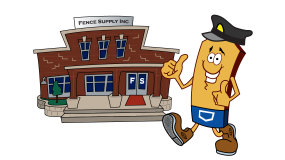People love wood fences for many reasons, like better privacy and the good looks of a wood fence. There are a range of wood fence materials out there, which might leave you scratching your head about which one is the best. We’ve had a lot of questions about cedar in particular, which is more costly, vs. other wood varieties which are more economical such as spruce or pine. Here are some things to think about to help you decide which is best for you.
Cost
As mentioned, cedar is generally the most expensive wood choice, followed by spruce and pine. Pressure treated woods vary depending on the supplier and the manufacturer. You know your budget, but remember: you get what you pay for. Don’t sacrifice quality for the bottom dollar, because you’ll spend more in the long run if you have to replace fence panels and posts every few years because you used cheaper wood.
Longevity
Cedar is the longest-lasting wood you can use. It’s naturally water-resistant, so it repels water and ages slower than other wood types. Cedar fence materials will last 20-30 years or more, depending on the species. Western red cedar is the most durable cedar variety. In comparison, untreated spruce pine lasts only 7-10 years if untreated, or 13-16 years if it’s treated. Buying treated wood or treating it yourself will increase the lifespan of any wood fence.
Strength and durability
The oil present in cedar fibers acts as natural pesticide, giving it increased resistance when used outdoors compared to other wood varieties. Cedar is also more flexible than other woods, which makes it less susceptible to splintering and breakage.
Handling and installation
The weight of the wood you choose makes a difference in the handling and installation of your fence. See the chart below for different weights per board foot of different materials.
| Material | Weight per board foot, in pounds |
| White Cedar | 2.3 |
| Spruce | 2.8 |
| White Pine | 3 |
| Red Cedar | 3.1 |
| Red Pine | 3.5 |
| Short Leaf Pine | 4.3 |
Lighter wood will be easier to handle and will require less installation labor. Also, softer woods will be easier to nail or screw into.
Other cedar advantages
Some other things to consider when choosing wood for your new fence:
- Stained cedar wood looks better than most wood varieties, because of its uniform texture and richly grained quality.
- The low-absorption qualities of cedar means that cedar warps less, and will not shrink and expand with the changing seasons.
- Cedar smells great; there is a reason why our grandmothers and grandfathers kept their prized possessions in cedar chests!
We think cedar makes for a better wood fence than other, cheaper options. It is true that some treated wood may last longer than cedar, but these treatments involve chemicals which may be toxic and cause health hazards. But cedar is naturally resistant to weather and insect damage, looks great, and smells wonderful, too.
For these reasons, we recommend cedar for investment value and quality.



